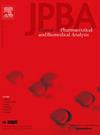Integration of four-dimensional proteomics and network pharmacology to reveal molecular mechanisms of multi-components multi-targets effects of Sini decoction on myocardial infarction
IF 3.1
3区 医学
Q2 CHEMISTRY, ANALYTICAL
Journal of pharmaceutical and biomedical analysis
Pub Date : 2024-10-23
DOI:10.1016/j.jpba.2024.116526
引用次数: 0
Abstract
Sini Decoction (SND) has been proven to be an effective formula to alleviate cardiac injury of myocardial infarction (MI). However, the potential mechanism of SND remains unclear. In this study, the MI rat model was established by ligating the left anterior descending coronary artery. A total of 17 SND-distributed components in heart were identified by using ultra-high performance liquid chromatography coupled with quadrupole-time-of-flight mass spectrometry (UHPLC-Q-TOFMS). The combination of four-dimensional (4D) proteomics and network pharmacology was employed to find the potential targets for therapeutic intervention, and molecular docking and cellular thermal shift assay (CETSA) were used to reveal the interactions between the potential targets and the potential active components distributed in heart of SND. 33 SND-effected proteins were identified by 4D proteomics, which was involved in carbon metabolism, fatty acid metabolism, valine, leucine and isoleucine degradation, tricarboxylic acid (TCA) cycle and PPAR signaling pathway. 17 potential SND-targeted direct proteins were screened by comparing SND-effected proteins generated from 4D proteomics with the MI-related proteins obtained from disease database. The potential relationships between 17 components and 17 potential SND-targeted direct proteins were established by molecular docking analysis, in which songorine, benzoylhypaconine, hypaconine, formononetin, and liquiritigenin could be bound to the surrounding amino acid residues in the binding pocket of Mtor, Parp1, Acadm, Crat, and Aldh2. Then, CETSA analysis further confirmed that songorine and benzoylhypaconine could increase the heat stability of Mtor and Parp1 in cardiac tissue lysate, respectively, which suggested that there existed direct interactions between songorine and Mtor, and benzoylhypaconine and Parp1. In summary, this work concluded that SND produced cardioprotective effects mainly through preserving energy metabolism, also demonstrated that the combination of 4D proteomics and network pharmacology was a promising tool for uncovering the molecular mechanisms of multi-components multi-targets effects of TCM.
四维蛋白质组学与网络药理学相结合,揭示西尼煎剂对心肌梗死多成分多靶点作用的分子机制
西尼煎剂(SND)已被证明是缓解心肌梗死(MI)心脏损伤的有效配方。然而,SND 的潜在机制仍不清楚。本研究通过结扎左前降支冠状动脉建立了心肌梗死大鼠模型。利用超高效液相色谱-四极杆飞行时间质谱(UHPLC-Q-TOFMS)鉴定了心脏中的17种SND分布成分。结合四维(4D)蛋白质组学和网络药理学,找到了潜在的治疗干预靶点,并利用分子对接和细胞热转移分析(CETSA)揭示了潜在靶点与分布在SND心脏中的潜在活性成分之间的相互作用。通过4D蛋白质组学鉴定了33个受SND影响的蛋白质,它们参与了碳代谢、脂肪酸代谢、缬氨酸、亮氨酸和异亮氨酸降解、三羧酸(TCA)循环和PPAR信号通路。通过将 4D 蛋白组学中生成的 SND 影响蛋白与疾病数据库中获得的 MI 相关蛋白进行比较,筛选出了 17 个潜在的 SND 靶向直接蛋白。通过分子对接分析,确定了17种成分与17种潜在的SND靶向直接蛋白之间的潜在关系,其中松果菊碱、苯甲酰基乌头原碱、次乌头原碱、formononetin和liquiritigenin可与Mtor、Parp1、Acadm、Crat和Aldh2结合口袋中的周围氨基酸残基结合。然后,CETSA分析进一步证实,松果菊碱和苯甲酰紫堇碱可分别增加Mtor和Parp1在心脏组织裂解液中的热稳定性,这表明松果菊碱与Mtor、苯甲酰紫堇碱与Parp1之间存在直接的相互作用。综上所述,本研究认为SND主要通过保护能量代谢产生心脏保护作用,同时也证明了四维蛋白质组学与网络药理学的结合是揭示中药多成分多靶点效应分子机制的一种很有前途的工具。
本文章由计算机程序翻译,如有差异,请以英文原文为准。
求助全文
约1分钟内获得全文
求助全文
来源期刊
CiteScore
6.70
自引率
5.90%
发文量
588
审稿时长
37 days
期刊介绍:
This journal is an international medium directed towards the needs of academic, clinical, government and industrial analysis by publishing original research reports and critical reviews on pharmaceutical and biomedical analysis. It covers the interdisciplinary aspects of analysis in the pharmaceutical, biomedical and clinical sciences, including developments in analytical methodology, instrumentation, computation and interpretation. Submissions on novel applications focusing on drug purity and stability studies, pharmacokinetics, therapeutic monitoring, metabolic profiling; drug-related aspects of analytical biochemistry and forensic toxicology; quality assurance in the pharmaceutical industry are also welcome.
Studies from areas of well established and poorly selective methods, such as UV-VIS spectrophotometry (including derivative and multi-wavelength measurements), basic electroanalytical (potentiometric, polarographic and voltammetric) methods, fluorimetry, flow-injection analysis, etc. are accepted for publication in exceptional cases only, if a unique and substantial advantage over presently known systems is demonstrated. The same applies to the assay of simple drug formulations by any kind of methods and the determination of drugs in biological samples based merely on spiked samples. Drug purity/stability studies should contain information on the structure elucidation of the impurities/degradants.

 求助内容:
求助内容: 应助结果提醒方式:
应助结果提醒方式:


